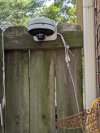These are just some tips I learned from terminating CAT-5, 6 or any ethernet cable with RJ-45 connectors
- Use pass-through RJ-45 connectors. You can strip the jacket back a few inches to work with longer wires for proper pin assignment and then cut off the excess wires.
- Proper termination becomes easier if the twisted wire pairs are straightened. They tend to stay in their assigned location as you pull the connector down to the jacket. I use the shank of a screwdriver to pull each wire individually between my thumb and the shank. I do this from 3 different angles, and the wire becomes straight as an arrow
- Use a good termination crimper. A good solid crimp is paramount to a good connection. I used to use an “Ideal” from the local home improvement stores with inconsistent results. I switched to a Trendnet TC-CT68 crimp tool and have had consistent solid crimps since.
- Use a cable tester to test and verify proper pin assignment and connection. You could use a fairly inexpensive model from Amazon for $10 - $15. They work well
- Use weather resistant couplers or “glands” in conjunction with dielectric grease to keep a good connection outdoors. Even with that, if the location has room for a camera junction box, use it. It will provide a second layer of protection for the connection, especially of the camera is out in the open.
Last edited:
As an Amazon Associate IPCamTalk earns from qualifying purchases.

